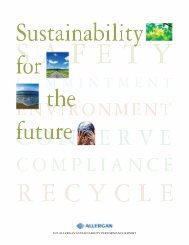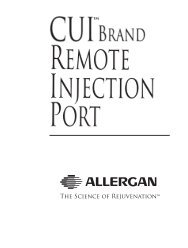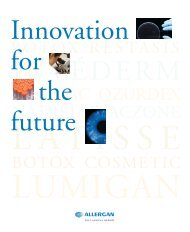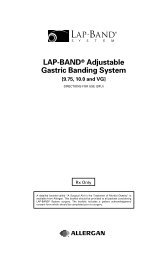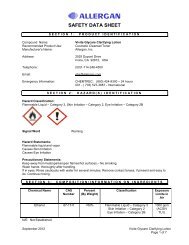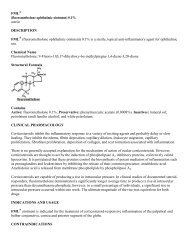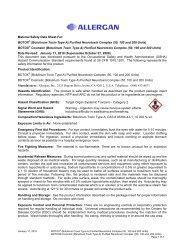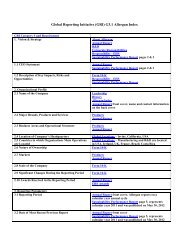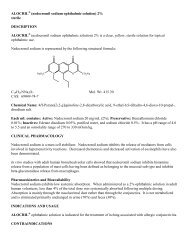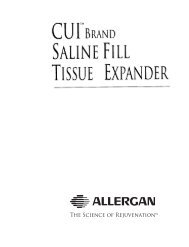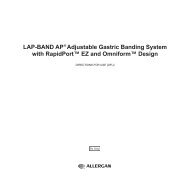ELESTAT® Prescribing Information - Allergan
ELESTAT® Prescribing Information - Allergan
ELESTAT® Prescribing Information - Allergan
You also want an ePaper? Increase the reach of your titles
YUMPU automatically turns print PDFs into web optimized ePapers that Google loves.
HIGHLIGHTS OF PRESCRIBING<br />
INFORMATION<br />
These highlights do not include all the information<br />
needed to use ELESTAT ® safely and effectively.<br />
See full prescribing information for ELESTAT ® .<br />
ELESTAT ® (epinastine HCl ophthalmic solution)<br />
0.05%<br />
Initial U.S. Approval: 2003<br />
_________ INDICATIONS AND USAGE ________<br />
ELESTAT ® is an H 1 histamine receptor antagonist<br />
indicated for the prevention of itching associated with<br />
allergic conjunctivitis. (1)<br />
______ DOSAGE AND ADMINISTRATION _____<br />
The recommended dosage is one drop in each eye<br />
twice a day. (2)<br />
____ DOSAGE FORMS AND STRENGTHS ______<br />
Ophthalmic solution containing 0.5 mg/mL epinastine<br />
HCl. (3)<br />
__________ CONTRAINDICATIONS ___________<br />
None (4)<br />
FULL PRESCRIBING INFORMATION:<br />
CONTENTS*<br />
1 INDICATIONS AND USAGE<br />
2 DOSAGE AND ADMINISTRATION<br />
3 DOSAGE FORMS AND STRENGTHS<br />
4 CONTRAINDICATIONS<br />
5 WARNINGS AND PRECAUTIONS<br />
5.1 Contamination of Tip and Solution<br />
5.2 Use with Contact Lenses<br />
5.3 Topical Ophthalmic Use Only<br />
6 ADVERSE REACTIONS<br />
6.1 Clinical Studies Experience<br />
6.2 Postmarketing Experience<br />
8 USE IN SPECIFIC POPULATIONS<br />
8.1 Pregnancy<br />
8.3 Nursing Mothers<br />
8.4 Pediatric Use<br />
8.5 Geriatric Use<br />
______ WARNINGS AND PRECAUTIONS ______<br />
<br />
<br />
<br />
To minimize the risk of contamination, do not<br />
touch dropper tip to any surface. Keep bottle<br />
tightly closed when not in use. (5.1)<br />
ELESTAT ® should not be used to treat contact<br />
lens-related irritation. (5.2)<br />
Remove contact lenses prior to instillation of<br />
ELESTAT ® . (5.2)<br />
___________ ADVERSE REACTIONS ___________<br />
The most common ocular adverse reactions (incidence<br />
occurring in approximately 1% - 10% of ELESTAT ®<br />
treated eyes were burning sensation in the eye,<br />
folliculosis, hyperemia, and pruritus. The most<br />
common non-ocular adverse reactions, occurring in<br />
10% of ELESTAT ® treated eyes, were infection (cold<br />
symptoms and upper respiratory infections). (6.1)<br />
To report SUSPECTED ADVERSE REACTIONS,<br />
contact <strong>Allergan</strong> at 1-800-433-8871 or the FDA at<br />
1-800-FDA-1088 or www.fda.gov/medwatch.<br />
See 17 for PATIENT COUNSELING<br />
INFORMATION<br />
Revised: 12/2011<br />
11 DESCRIPTION<br />
12 CLINICAL PHARMACOLOGY<br />
12.1 Mechanism of Action<br />
12.3 Pharmacokinetics<br />
13 NONCLINICAL TOXICOLOGY<br />
13.1 Carcinogenesis, Mutagenesis,<br />
Impairment of Fertility<br />
14 CLINICAL STUDIES<br />
16 HOW SUPPLIED/STORAGE AND<br />
HANDLING<br />
17 PATIENT COUNSELING<br />
INFORMATION<br />
17.1 Sterility of Dropper Tip<br />
17.2 Concomitant Use of Contact Lenses<br />
17.3 Topical Ophthalmic Use Only<br />
* Sections or subsections omitted from the full<br />
prescribing information are not listed
FULL PRESCRIBING INFORMATION<br />
1 INDICATIONS AND USAGE<br />
ELESTAT ® ophthalmic solution is indicated for the prevention of itching associated with allergic<br />
conjunctivitis.<br />
2 DOSAGE AND ADMINISTRATION<br />
The recommended dosage is one drop in each eye twice a day.<br />
Treatment should be continued throughout the period of exposure (i.e., until the pollen season is over or until<br />
exposure to the offending allergen is terminated), even when symptoms are absent.<br />
3 DOSAGE FORMS AND STRENGTHS<br />
Solution containing 0.5 mg/mL epinastine HCl<br />
4 CONTRAINDICATIONS<br />
None<br />
5 WARNINGS AND PRECAUTIONS<br />
5.1 Contamination of Tip and Solution<br />
Patients should be instructed to avoid allowing the tip of the dispensing container to contact the eye,<br />
surrounding structures, fingers, or any other surface in order to avoid contamination of the solution by common<br />
bacteria known to cause ocular infections. Serious damage to the eye and subsequent loss of vision may result<br />
from using contaminated solutions.<br />
Bottle should be kept tightly closed when not in use.<br />
5.2 Use with Contact Lenses<br />
Patients should be advised not to wear a contact lens if their eye is red. ELESTAT ® ophthalmic solution should<br />
not be used to treat contact lens-related irritation.<br />
The preservative in ELESTAT ® , benzalkonium chloride, may be absorbed by soft contact lenses. Contact<br />
lenses should be removed prior to instillation of ELESTAT ® ophthalmic solution and may be reinserted after<br />
10 minutes following its administration.<br />
5.3 Topical Ophthalmic Use Only<br />
ELESTAT ® is for topical ophthalmic use only and not for injection or oral use.<br />
6 ADVERSE REACTIONS<br />
6.1 Clinical Studies Experience<br />
Because clinical studies are conducted under widely varying conditions, adverse reaction rates observed in the<br />
clinical studies of a drug cannot be directly compared to rates in the clinical studies of another drug and may not<br />
reflect the rates observed in practice.<br />
The most frequently reported ocular adverse reactions occurring in approximately 1-10% of patients were<br />
burning sensation in the eye, folliculosis, hyperemia, and pruritus.<br />
The most frequently reported non-ocular adverse reactions were infection (cold symptoms and upper respiratory<br />
infections), seen in approximately 10% of patients, and headache, rhinitis, sinusitis, increased cough, and<br />
pharyngitis, seen in approximately 1 - 3% of patients.<br />
Some of these reactions were similar to the underlying disease being studied.
6.2 Postmarketing Experience<br />
The following reactions have been identified during postmarketing use of ELESTAT ® in clinical practice.<br />
Because they are reported voluntarily from a population of unknown size, estimates of frequency cannot be<br />
made. The reactions, which have been chosen for inclusion due to either their seriousness, frequency of<br />
reporting, possible causal connection to ELESTAT ® , or a combination of these factors, include: lacrimation<br />
increased.<br />
8 USE IN SPECIFIC POPULATIONS<br />
8.1 Pregnancy<br />
Teratogenic Effects<br />
Pregnancy Category C<br />
In an embryofetal developmental study in pregnant rats, maternal toxicity with no embryofetal effects was<br />
observed at an oral dose that was approximately 150,000 times the maximum recommended ocular human dose<br />
(MROHD) of 0.0014 mg/kg/day on a mg/kg basis. Total resorptions and abortion were observed in an<br />
embryofetal study in pregnant rabbits at an oral dose that was approximately 55,000 times the MROHD. In both<br />
studies, no drug-induced teratogenic effects were noted.<br />
Epinastine reduced pup body weight gain following an oral dose to pregnant rats that was approximately 90,000<br />
times the MROHD.<br />
There are, however, no adequate and well-controlled studies in pregnant women. Because animal reproduction<br />
studies are not always predictive of human response, ELESTAT ® ophthalmic solution should be used during<br />
pregnancy only if the potential benefit justifies the potential risk to the fetus.<br />
8.3 Nursing Mothers<br />
A study in lactating rats revealed excretion of epinastine in the breast milk. It is not known whether this drug is<br />
excreted in human milk. Because many drugs are excreted in human milk, caution should be exercised when<br />
ELESTAT ® ophthalmic solution is administered to a nursing woman.<br />
8.4 Pediatric Use<br />
Safety and effectiveness in pediatric patients below the age of 2 years have not been established.<br />
8.5 Geriatric Use<br />
No overall differences in safety or effectiveness have been observed between elderly and younger patients.<br />
11 DESCRIPTION<br />
ELESTAT ® (epinastine HCl ophthalmic solution) 0.05% is a clear, colorless, sterile isotonic solution<br />
containing epinastine HCl, an antihistamine and an inhibitor of histamine release from the mast cell for topical<br />
administration to the eyes.<br />
Epinastine HCl is represented by the following structural formula:<br />
C 16 H 15 N 3 HCl Mol. Wt. 285.78
Chemical Name:<br />
3-Amino-9,13b-dihydro-1H-dibenz[c,f]imidazo[1,5-a]azepine hydrochloride<br />
Each mL contains: Active: Epinastine HCl 0.05% (0.5 mg/mL) equivalent to epinastine 0.044% (0.44<br />
mg/mL); Preservative: Benzalkonium chloride 0.01%; Inactives: Edetate disodium; purified water; sodium<br />
chloride; sodium phosphate, monobasic; and sodium hydroxide and/or hydrochloric acid (to adjust pH).<br />
ELESTAT ® has a pH of approximately 7 and an osmolality range of 250 to 310 mOsm/kg.<br />
12 CLINICAL PHARMACOLOGY<br />
12.1 Mechanism of Action<br />
Epinastine is a topically active, direct H 1 -receptor antagonist and an inhibitor of the release of histamine from<br />
the mast cell. Epinastine is selective for the histamine H 1 -receptor and has affinity for the histamine H 2 -<br />
receptor. Epinastine also possesses affinity for the α 1 , α 2 -, and 5-HT 2 –receptors.<br />
12.3 Pharmacokinetics<br />
Fourteen subjects, with allergic conjunctivitis, received one drop of ELESTAT ® ophthalmic solution in each<br />
eye twice daily for 7 days. On day 7, average maximum epinastine plasma concentrations of 0.04±0.014 ng/ml<br />
were reached after about two hours indicating low systemic exposure. While these concentrations represented<br />
an increase over those seen following a single dose, the day 1 and day 7 Area Under the Curve (AUC) values<br />
were unchanged indicating that there is no increase in systemic absorption with multiple dosing. Epinastine is<br />
64% bound to plasma proteins. The total systemic clearance is approximately 56 L/hr and the terminal plasma<br />
elimination half-life is about 12 hours. Epinastine is mainly excreted unchanged. About 55% of an intravenous<br />
dose is recovered unchanged in the urine with about 30% in feces. Less than 10% is metabolized. The renal<br />
elimination is mainly via active tubular secretion.<br />
13 NONCLINICAL TOXICOLOGY<br />
13.1 Carcinogenesis, Mutagenesis, Impairment of Fertility<br />
In 18-month or 2-year dietary carcinogenicity studies in mice or rats, respectively, epinastine was not<br />
carcinogenic at doses up to 40 mg/kg [approximately 30,000 times higher than the MROHD, assuming 100%<br />
absorption in humans and animals].<br />
Epinastine in newly synthesized batches was negative for mutagenicity in the Ames/Salmonella assay and in<br />
vitro chromosome aberration assay using human lymphocytes. Positive results were seen with early batches of<br />
epinastine in two in vitro chromosomal aberration studies conducted in 1980s with human peripheral<br />
lymphocytes and with V79 cells, respectively. Epinastine was negative in the in vivo clastogenicity studies,<br />
including the mouse micronucleus assay and chromosome aberration assay in Chinese hamsters. Epinastine was<br />
also negative in the cell transformation assay using Syrian hamster embryo cells, V79/HGPRT mammalian cell<br />
point mutation assay, and in vivo/in vitro unscheduled DNA synthesis assay using rat primary hepatocytes.<br />
Epinastine had no effect on fertility of male rats. Decreased fertility in female rats was observed at an oral dose<br />
up to approximately 90,000 times the MROHD.<br />
14 CLINICAL STUDIES<br />
Epinastine HCl 0.05% has been shown to be significantly superior to vehicle for improving ocular itching in<br />
patients with allergic conjunctivitis in clinical studies using two different models: (1) conjunctival antigen<br />
challenge (CAC) where patients were dosed and then received antigen instilled into the inferior conjunctival<br />
fornix; and (2) environmental field studies where patients were dosed and evaluated during allergy season in<br />
their natural habitat. Results demonstrated a rapid onset of action for epinastine HCl 0.05% within 3 to 5<br />
minutes after conjunctival antigen challenge. Duration of effect was shown to be 8 hours, making a twice daily<br />
regimen suitable. This dosing regimen was shown to be safe and effective for up to 8 weeks, without evidence<br />
of tachyphylaxis.
16 HOW SUPPLIED/STORAGE AND HANDLING<br />
ELESTAT ® (epinastine HCl ophthalmic solution) 0.05% is supplied sterile in opaque white LDPE plastic<br />
bottles with dropper tips and white high impact polystyrene (HIPS) caps as follows:<br />
5 mL in 10 mL bottle NDC 0023-9201-05<br />
Storage: Store at 15º-25ºC (59º-77ºF). Keep bottle tightly closed and out of the reach of children.<br />
17 PATIENT COUNSELING INFORMATION<br />
17.1 Sterility of Dropper Tip<br />
Patients should be advised not to touch dropper tip to any surface, as this may contaminate the contents (see<br />
WARNINGS AND PRECAUTIONS, 5.1).<br />
17.2 Concomitant Use of Contact Lenses<br />
Patients should be advised not to wear a contact lens if their eye is red. Patients should be advised that<br />
ELESTAT ® should not be used to treat contact lens-related irritation. Patients should also be advised to remove<br />
contact lenses prior to instillation of ELESTAT ® . The preservative in ELESTAT ® , benzalkonium chloride,<br />
may be absorbed by soft contact lenses. Lenses may be reinserted after 10 minutes following administration of<br />
ELESTAT ® .<br />
17.3 Topical Ophthalmic Use Only<br />
For topical ophthalmic administration only.<br />
Rx only<br />
© 2012 <strong>Allergan</strong>, Inc.<br />
Irvine, CA 92612, U.S.A.<br />
<strong>Allergan</strong> corporate signature logo is a registered trademark of <strong>Allergan</strong>, Inc.<br />
ELESTAT is a registered trademark of Boehringer Ingelheim International GmbH and is licensed to <strong>Allergan</strong>,<br />
Inc.<br />
Made in the U.S.A.<br />
72499US10



